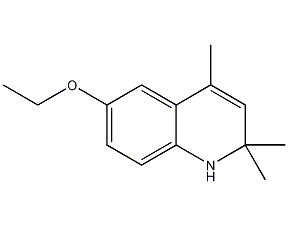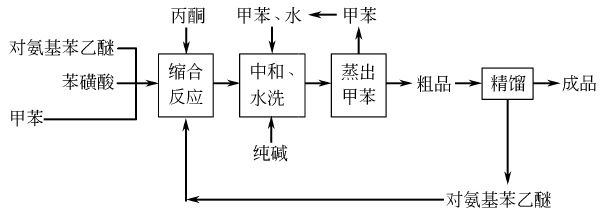
Structural formula
| Business number | 023L |
|---|---|
| Molecular formula | C14H19NO |
| Molecular weight | 217.31 |
| label |
Ethoxyquin, 1,2-dihydro-6-ethoxy-2,2,4-trimethylquinoline, Anti-aging agent AW, Santoquin, Ethoxyquin, Fungicide |
Numbering system
CAS number:91-53-2
MDL number:MFCD00023883
EINECS number:202-075-7
RTECS number:VB8225000
BRN number:158223
PubChem number:24894671
Physical property data
1. Properties: light brown viscous liquid
2. Relative density (g/mL, 25/4℃): 1.029-1.031
3. Relative vapor density ( g/mL, air=1): Undetermined
4. Melting point (ºC): 183-184
5. Boiling point (ºC, 1.47KPa): 169
6. Boiling point (ºC, 0.267kpa): 123-125
7. Refractive index (25℃): 1.569-1.627
8. Flash point (ºC) : Undetermined
9. Specific rotation (º): Undetermined
10. Autoignition point or ignition temperature (ºC): Undetermined
11 . Vapor pressure (kPa, 25ºC): Undetermined
12. Saturation vapor pressure (kPa, 60ºC): Undetermined
13. Heat of combustion (KJ/mol): Undetermined
14. Critical temperature (ºC): Undetermined
15. Critical pressure (KPa): Undetermined
16. Oil and water (octanol/water) Log value of distribution coefficient: Undetermined
17. Explosion upper limit (%, V/V): Undetermined
18. Explosion lower limit (%, V/V): Undetermined
19. Solubility: Soluble in benzene, gasoline, ether, alcohol, carbon tetrachloride, acetone, dichloroethane, insoluble in water.
Toxicological data
Toxicity Classification Poisoning
Acute toxicity: Oral – rat LD50 800 mg/kg; Oral – mouse LD50: 1584 mg/kg.
Ecological data
Slightly harmful to water bodies.
Molecular structure data
1. Molar refractive index: 66.71
2. Molar volume (cm3/mol): 222.4
3. Isotonic specific volume (90.2K ): 519.8
4. Surface tension (dyne/cm): 29.7
5. Polarizability (10-24cm3): 26.44
Compute chemical data
1.�Reference value for calculation of water parameters (XlogP): 3.1
2. Number of hydrogen bond donors: 1
3. Number of hydrogen bond acceptors: 2
4. Number of rotatable chemical bonds: 2
5. Number of tautomers: none
6. Topological molecule polar surface area 21.3
7. Heavy Number of atoms: 16
8. Surface charge: 0
9. Complexity: 283
10. Number of isotope atoms: 0
11. Determine the number of atomic stereocenters: 0
12. Uncertain number of atomic stereocenters: 0
13. Determine the number of chemical bond stereocenters: 0
14. Number of uncertain chemical bond stereocenters: 0
15. Number of covalent bond units: 1
Properties and stability
1. The pure product is a light brown viscous liquid with relatively stable properties.
2. Soluble in benzene, gasoline, ether, alcohol, carbon tetrachloride, acetone, and dichloroethane, but insoluble in water. Non-toxic.
Storage method
Should be kept sealed in a cool, ventilated place. Fireproof, moistureproof and sunproof.
Synthesis method
1. Obtained from the condensation of p-aminophenylene ether and acetone. Under the catalysis of benzene sulfonic acid, p-aminophenylene ether and acetone undergo a condensation reaction at 155-165°C. The water and unreacted acetone generated by the reaction are returned to the acetone evaporator for recycling. After the condensation reaction, the finished product is obtained by distillation. You can also use 1% iodine and catalyst to perform the condensation reaction at 120-130°C. Raw material consumption (kg/t) p-aminophenylene ether 1000 acetone 800 benzenesulfonic acid 100

Each ton of product consumes 1000kg of p-aminophenylene ether, 800kg of acetone, and 100kg of benzenesulfonic acid. The process flow
is as follows:
You can also use 1% iodine, concentrated hydrochloric acid, aluminum trichloride, hydrogen bromide, etc. as catalysts to perform a condensation reaction at 100 to 170°C to prepare ethoxy Quin.
2.Generally obtained from the condensation of p-aminophenylene ether and acetone under the action of a catalyst.
3.It is prepared by the condensation reaction of p-aminophenylene ether and acetone under the catalysis of benzenesulfonic acid.
Purpose
1. This product is widely used as an antioxidant in feed and food. Spraying this product on dehydrated feed or pre-harvest feed crops can prevent fat and protein feed from deteriorating during storage. It can be used to preserve vitamin A, vitamin E and other medicines. Prevent the formation of organic peroxides in canned meat products and animal feed. Improve the uptake of vitamin E in chicks and use it to maintain normal levels. Improve carcass quality and increase animal weight. This product can also be used to preserve apples, pears and other fruits; it is reported that ethoxyquin is an effective protective agent to prevent sheep from being poisoned by eating rubber grass. This product is also a polluting rubber antioxidant (antioxidant AW), mainly used in natural rubber and synthetic rubber, especially styrene-butadiene rubber. It has excellent oxygen resistance and ozone resistance, as well as good weather resistance, heat resistance and flex crack resistance. The general dosage is 1-2 parts, sometimes it can be increased to 3-4 parts. It has a synergistic effect with 4010NA and paraffin wax, which can further improve the protective effect. This product is not easy to bloom, but it is highly polluting and is not suitable for light colors and Colorful products. This product is used on apples and pears to prevent and cure apple tiger skin disease. When used as a feed additive, this product has low toxicity and is safe to use. The residual amounts in poultry fat, liver, and muscle are 0.238, 0.048, and 0.005ml/kg respectively. The residual amount in eggs is 0.031 mg/kg, mainly distributed in egg yolks, and the maximum tolerance of the human body is 60 μg/kg.
2.Ethoxyquinoline has preservation and antioxidant effects. It is mainly used to preserve the freshness of fruits and prevent and treat black skin disease of apples, pears, bananas, etc. Our country stipulates that it can be used to preserve apples and should be used in appropriate amounts according to production needs. Residue amount 1mg/kg . It can also be used as an antioxidant for vitamin A, vitamin D, beta-carotene, fat and other substances.
3.Feed antioxidants. It has a good antioxidant effect, can effectively prevent the oxidation and spoilage of fats and proteins in feed, prevent the oxidation and deterioration of vitamin A, carotene, and vitamin E, keep the various nutrients of feed and fat from being destroyed, and extend the storage time.
4. Rubber antioxidant is especially suitable for rubber products (such as tires, rubber shoes, etc.) used under dynamic conditions. It is not suitable for brightly colored and light-colored products. Used in conjunction with antioxidant H, antioxidant 4010, wax antioxidants, etc., it has a synergistic effect. The dosage is generally 1%~3%. This product can also be used as an antioxidant in oil, food and feed processing.


